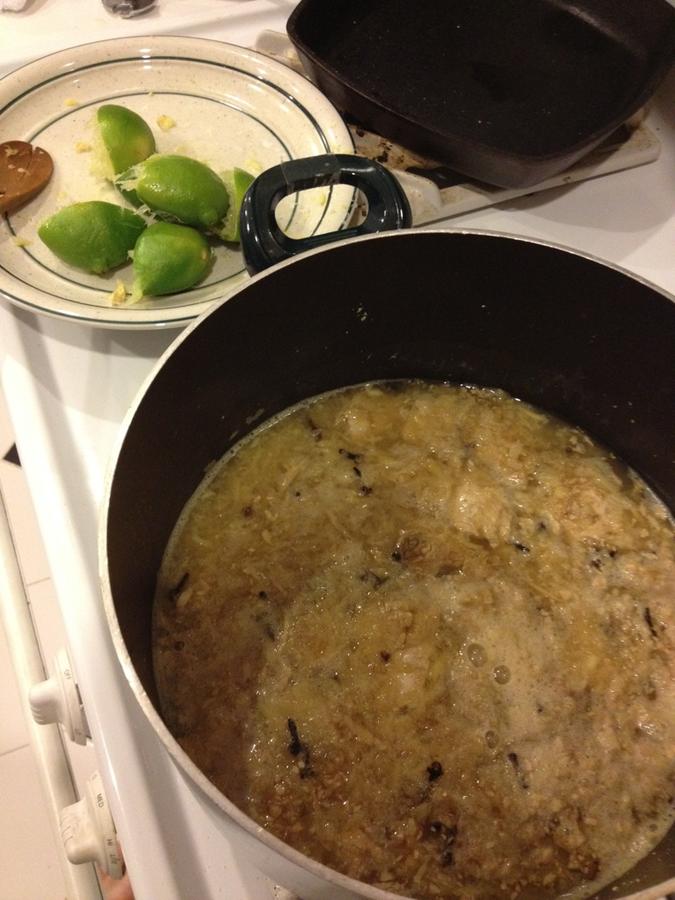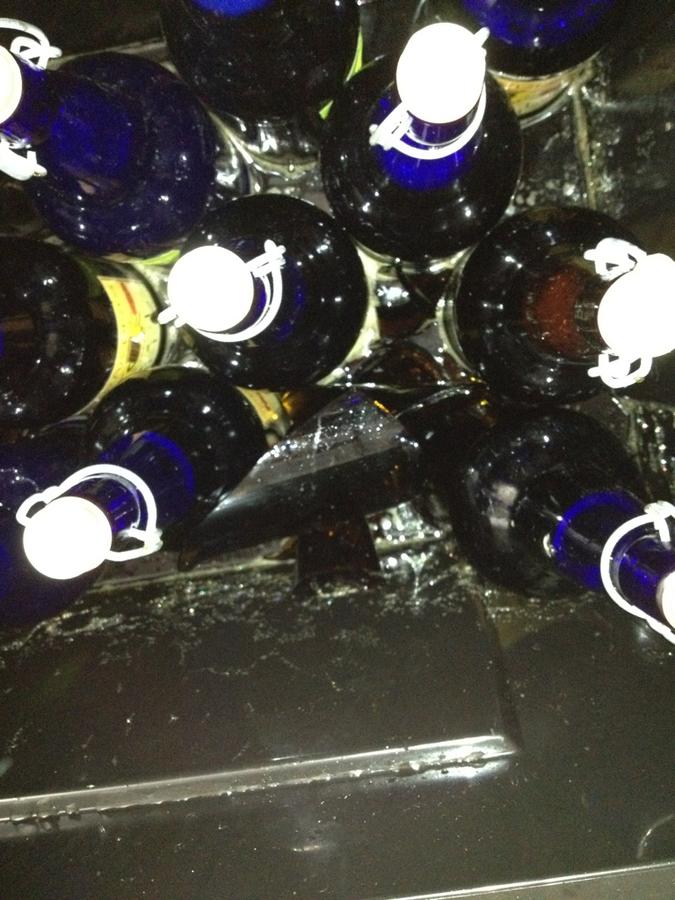I just tossed together a batch of ginger ale last night. It's non-alcoholic, but since I'm carbonating using yeast and sugar that counts as brewing in my book. I've modified my recipe from the last batch I made. I want this one to have quite a bite to it.
Total yield is 3.5 gallons (14 quarts). Here's my recipe if anyone is curious:
12 oz finely grated ginger root (approximately).
juice from 3 limes
2 TBSP whole cloves
1 cinnamon stick
2 TBSP molasses (I shorted it a tad since I was using Brer Rabbit)
6 2/3 Cup turbinado
1/2 tsp dark ale yeast
Simmer all ingredients except sugar and yeast in 2-3 quarts of water. Let simmer, uncovered for about 20 minutes. This will make your house smell awesome. Then pull from heat and add sugar. Here's a shot while simmering. I love this smell.
Once the sugar is fully dissolved, put the remaining water into your bottling pail. Pour the wort (I think this would be considered a wort anyway. Forgive the non-alcohol brewer if I'm using terms wrong) through a strainer to pick out the chunks. There will be a few chunks that make it through, but that's OK. I like it when a few chunks make it into the final product because they continue to steep, adding further bite to the finished product.
Meanwhile, get your yeast started in a little water, about 100 degrees. I usually add a little sugar in with it to get it kick started. Don't know if this is just superstition or actually does something. I saw my dad do it as a kid, so that's where that comes from.
The final batch should be somewhere between 100-110 F when you add in the yeast. Add in the yeast to your bottling pail, then mix it up real good. I use a bay mixer to diffuse the yeast around as much as possible, and even whip a bit of air into the mix. Again, I don't know if that step makes a difference or is just superstition, but it's part of the fun. Then bottle and cap it.
I use a plastic Coke bottle as a tester (not pictured). Fill it about 4/5 or so, leaving some oxygen for the yeast to work with. A plastic bottle is useful because you can squeeze it and get a sense for how carbonated it is. When it is as firm as a Coke you'd buy from the store, it's time to get it out of the heat, or risk exploding bottles.
One ugly brewmaster:
When you're bottling, bear in mind that the more oxygen you leave in the bottle, the more carbon dioxide it will produce (as well as alcohol, although this is unlikely to leave anything more than a very small trace). But they yeast will also multiply more, which can leave you with a yeasty taste in your final product, so there's a point of diminishing return. You can see in the clear bottles how much air I try to leave for the finished product.
Once it's bottled, I put it in plastic tubs with a lid that can be clamped down, and put it somewhere it will get hot. This is important because you will have a bottle explode on you occasionally. I prefer to contain the glass shards and sticky mess this way in the event of bottle attrition.
It'll all be done in about 3 days based on how hot it's been out here recently.
Thanks for looking! I have quite a bit of fun brewing this stuff. I hope it tastes good. I'll let you know.
Total yield is 3.5 gallons (14 quarts). Here's my recipe if anyone is curious:
12 oz finely grated ginger root (approximately).
juice from 3 limes
2 TBSP whole cloves
1 cinnamon stick
2 TBSP molasses (I shorted it a tad since I was using Brer Rabbit)
6 2/3 Cup turbinado
1/2 tsp dark ale yeast
Simmer all ingredients except sugar and yeast in 2-3 quarts of water. Let simmer, uncovered for about 20 minutes. This will make your house smell awesome. Then pull from heat and add sugar. Here's a shot while simmering. I love this smell.
Once the sugar is fully dissolved, put the remaining water into your bottling pail. Pour the wort (I think this would be considered a wort anyway. Forgive the non-alcohol brewer if I'm using terms wrong) through a strainer to pick out the chunks. There will be a few chunks that make it through, but that's OK. I like it when a few chunks make it into the final product because they continue to steep, adding further bite to the finished product.
Meanwhile, get your yeast started in a little water, about 100 degrees. I usually add a little sugar in with it to get it kick started. Don't know if this is just superstition or actually does something. I saw my dad do it as a kid, so that's where that comes from.
The final batch should be somewhere between 100-110 F when you add in the yeast. Add in the yeast to your bottling pail, then mix it up real good. I use a bay mixer to diffuse the yeast around as much as possible, and even whip a bit of air into the mix. Again, I don't know if that step makes a difference or is just superstition, but it's part of the fun. Then bottle and cap it.
I use a plastic Coke bottle as a tester (not pictured). Fill it about 4/5 or so, leaving some oxygen for the yeast to work with. A plastic bottle is useful because you can squeeze it and get a sense for how carbonated it is. When it is as firm as a Coke you'd buy from the store, it's time to get it out of the heat, or risk exploding bottles.
One ugly brewmaster:
When you're bottling, bear in mind that the more oxygen you leave in the bottle, the more carbon dioxide it will produce (as well as alcohol, although this is unlikely to leave anything more than a very small trace). But they yeast will also multiply more, which can leave you with a yeasty taste in your final product, so there's a point of diminishing return. You can see in the clear bottles how much air I try to leave for the finished product.
Once it's bottled, I put it in plastic tubs with a lid that can be clamped down, and put it somewhere it will get hot. This is important because you will have a bottle explode on you occasionally. I prefer to contain the glass shards and sticky mess this way in the event of bottle attrition.
It'll all be done in about 3 days based on how hot it's been out here recently.
Thanks for looking! I have quite a bit of fun brewing this stuff. I hope it tastes good. I'll let you know.











